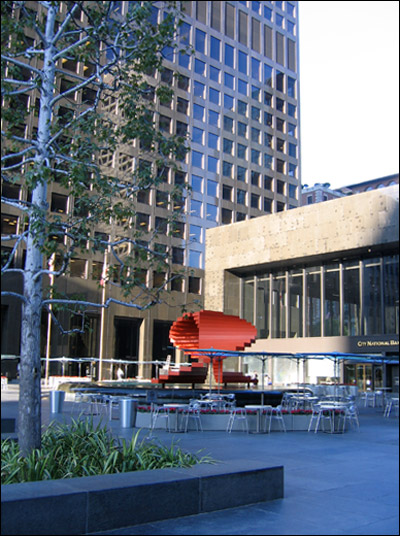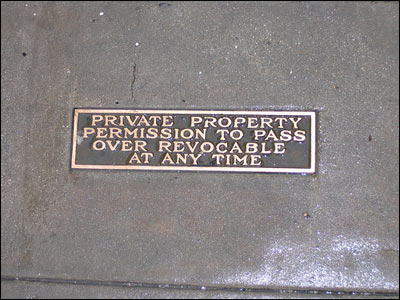![]()
This article is part of a collaboration with Planetizen, the web’s leading resource for the urban planning, design, and development community.
Cities are filled with spaces intended for the public — but many of them are clearly owned and operated by the private sector. Though cities bend rules to get these spaces built, the public benefit is often outweighed by the cost. The challenge now is to make them better.
The difference between what is public and what is private is usually pretty clear. A city park is available to everyone. Your neighbor’s living room is not. But the line dividing public and private can blur, and when it does, spaces get ambiguous, and questions arise. Who can use them? What are they for? Who’s in charge?
These spaces exist in cities all over the country, mainly in the form of plazas in front of office buildings — built by developers, owned by private interests, but used by the public. The downtowns of America are littered with them, which has periodically caused debate about what to do with these private-yet-public spaces. Most recently, a report from the San Francisco Planning and Urban Research Association (SPUR) sought to document and evaluate these privately owned public spaces in the downtown office district of San Francisco. The report looks at the history of these spaces, the policies that permitted, shaped, and even encouraged them — and where their designs often fall short.
Privately owned public spaces in San Francisco and throughout the country have produced mixed results over the years. They’re typically built as a trade-off between the city and the developer in which the city allows the developer to build more or higher in exchange for developing a plaza, atrium, or a seating area for public use. New York City was the first to institute this trade-off, now known as incentive zoning, and other cities like San Francisco have followed.
“By allowing bigger buildings than would otherwise be allowed by the zoning, the city is essentially saying ‘we’re willing to violate legally what we would otherwise think is appropriate because we’re getting something back in return that is even better.’ So it better be better,” said Jerold Kayden, professor and co-chair of the Department of Urban Planning at Harvard University. He’s also the author of “Privately Owned Public Space: The New York City Experience”, an extensive study of more than 500 of these spaces conducted from 1998 to 1999. His study, and the subsequent studies it inspired, have found that the public benefit of these spaces is largely disproportionate to the benefits enjoyed by developers.

SPUR’s report proposes a new way forward for these spaces, but progress depends on the past — maybe even more than on the future. Of the 68 spaces the report documented, 45 were built before 1985. Nearly half of these suffer from what the SPUR report’s authors call “inferior design”, making them less useful to the public they are intended to serve. A variety of changes are needed to make these places more useful, according to the recommendations in the report, which range from improved signage to expanded hours of operation to the provision of moveable seating.
“These spaces are only as public as they’re used by the public,” said Sarah Karlinsky, SPUR’s deputy director. “So their publicness increases through use, basically, and the only way people know to use them is to know that they exist. And the only way for them to know that they exist is through publicity of the spaces.”
Intended uses and users
Often, the problem with many of these spaces is the fact that they are underused. The office lunch crowd typically fills benches and seating areas, but after lunch and after office hours, the spaces are virtually abandoned.
“These spaces do provide amenities for downtown workers, mostly white collar workers and employees. I don’t want to say that these are completely with no use,” says Anastasia Loukaitou-Sideris, professor and chair of the Department of Urban Planning at the University of California, Los Angeles. She’s also co-author of “Urban Design Downtown: Poetics and Politics of Form”, which looks at downtown Los Angeles’ public spaces. “With more residents in downtown, I believe there’s going to be more use of these spaces. But I think they will keep some of their characteristics that still make them more private than public spaces.”
The root of the problem posed by these spaces, the experts say, is their ambiguity. They are intended for the public, but when the “public” is a crowd of, say, homeless people, many of these public spaces teeter more toward the private edge of the spectrum. In her studies of L.A.’s public spaces for her 1998 book, Loukaitou-Sideris noted a distinct stratum of users of these spaces — and little patience for anyone else.
“They do target a very specific segment of the public, which is more of the white collar office worker, the tenant of the building, the shopper, and they don’t have much tolerance for the rowdy teenager or the bag lady or the homeless person,” she said.
The blurry line is harnessed and the crowd is selectively determined in many of these public spaces by what Loukaitou-Sideris calls “soft control” and “hard control.”
“There is certainly a screening of who gets to use these places through mostly soft control, and this means the price of the merchandise, the fact that you have to buy something in order to sit, the fact that major entrances are through parking structures,” she said. “And sometimes the hard control practices are through private security, that if they see someone that looks more like a bag lady or homeless or even if you’re underdressed, you would be asked to probably leave.”

SPUR also recommends the creation of a watchdog or “friends of” group to look after and program activities in these spaces. It’s an idea based on Advocates for Privately-Owned Public Space, a non-profit set up in New York City by Kayden after the publication of his study in 2000. The group is a largely volunteer-run organization that monitors the city’s privately owned public spaces and works with the city to encourage upgrades and promote use.
“This ends up being, to be sure, a second best alternative, but it’s better than the third best alternative, which is to do nothing,” said Kayden. “There are other mechanisms that can be used, but having a friend of these spaces or an advocate of these spaces I think is a very reasonable idea.”
“What’s crucial is to recognize these are public spaces and they lack an overall person to look after them.”
Karlinsky agrees with Kayden that such public-private partnerships are likely the best way to ensure the maintenance and operation of these spaces, especially as city positions are cut and budgets plummet.
“I think it’s going to be a combination of grassroots work and the public sector taking hold of some of the ideas,” Karlinsky said. “I’d like to think that the public sector will be responsive to these recommendations, to the extent that they can be.”
She’s hoping the report will guide policy relating to future privately owned public spaces in an effort to improve their design and utility to the public. But given the current economic downturn, t
he report’s recommendations for new spaces may not get too many chances to take shape.
Adapting to changing downtowns
“Because of the troubles in the real estate sector, we have not seen that many more coming about — at least in Los Angeles — and I would speculate in many other cities,” said Loukaitou-Sideris, of the likely slowdown in the construction of such spaces.
“I mean, we can change the rules now going forward, but how many new office buildings are going up in San Francisco right now? Or Los Angeles?” Kayden asks. “Over the next five years, I don’t think we’re going to see a hell of a lot of new buildings with public space. So let’s focus on the existing inventory.”
And as downtowns across the country enter into a renaissance of redevelopment and residentialization, new questions emerge about what role these spaces play — and should play — as downtown demographics shift. More housing and increasing downtown populations are seen as good signs for privately owned public spaces.
“I think the more people who live in the city in addition to work in the city and visit the city, the more possibility there is for use of these spaces,” says Kayden, “but only if they’re attractive and functional and even creative and inventive.”
Whether new life in downtowns across the country result in new use of these spaces remains to be seen, but in the meantime, studies like SPUR’s report, the work of Jerold Kayden in New York and various other resulting studies in cities around the U.S. will offer new ideas for taking more advantage of the public spaces cities have. They’ve all identified areas in which privately owned public spaces fail, but they also express the understanding that these places can and do serve a purpose.
“At their best, they do add. They’re not Central Park. They’re not Pershing [Square] Park. They’re not Golden Gate Park. They’re not that size and they’re not that good,” said Kayden. “But they’re scattered about and they provide in a dense congested city environment the possibility for all of the sorts of informal kinds of activities, solitary or in groups, that you might like to have that you can’t have in the middle of the street or in the middle of the sidewalk.”

